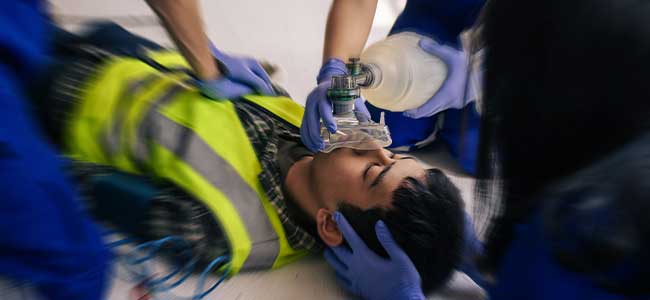
The Details of AEDs
What you didn’t know about CPR and defibrillation could save a life.
- By Cindy Pauley
- Jun 01, 2023
Automated external defibrillators (AEDs) and cardiopulmonary resuscitation (CPR) are the perfect tools for aiding a cardiac arrest victim while awaiting emergency medical assistance. Quick action using CPR and AEDs can save the lives of the nearly 350,000 cardiac event victims each year outside of a hospital setting. But what does OSHA require employers to do? What you didn’t know about OSHA regulations regarding AEDs may be surprising.
Understanding the Heart of the Matter
To understand how CPR and defibrillation work, it’s best to understand what is happening inside the body during a cardiac arrest. The cardiovascular system, made up of the heart, blood and blood vessels, transports oxygen and nutrients to body tissues and removes waste that’s eliminated by the lungs.
The fist-sized heart is located between the sternum and the spine. For an average adult, it beats 60 to 80 times per minute to circulate approximately five to six liters of blood. Divided into four chambers (two atria and two ventricles), the heart is composed of sophisticated muscle tissue that generates its own electrical impulses. These impulses help contract the heart, allowing oxygen-poor blood to leave the heart and oxygen-rich blood to return from the lungs. The heart filling and then pushing blood out is what is felt as the pulse.
All body systems rely on a properly functioning circulatory system. When something disrupts circulation, shock can occur. If multiple cells of an organ die from oxygen deprivation, the organ dies within minutes. When critical organs die, the victim can also die within minutes. The goal of CPR is to circulate oxygenated blood to keep vital organs alive until help arrives.
Signs and Symptoms of Cardiac Compromise
Think of the circulatory system as the body’s blood transportation system and the heart as the engine. Amazingly, the heart generates its own electrical impulses, pumping in a regular, rhythmic manner. As with any engine, the heart requires a certain amount of pressure to function and doesn’t work well when clogged with grease or debris.
The most common causes of sudden cardiac arrest include a heart attack, electrocution and asphyxiation—all of which could occur in the workplace. Common signs and symptoms of cardiac compromise include:
- Chest pain accompanied by a crushing or squeezing sensation,
- Pain that radiates to the jaw or arm,
- Irregular pulse and/or abnormal blood pressure,
- Shortness of breath,
- Cool and sweaty skin,
- Nausea and vomiting, and
- Anxiety or feeling of impending doom.
This article originally appeared in the June 1, 2023 issue of Occupational Health & Safety.